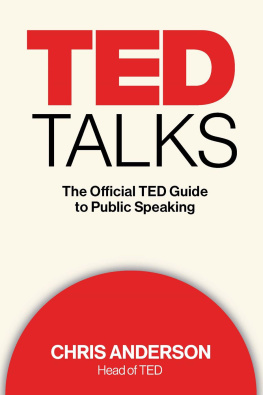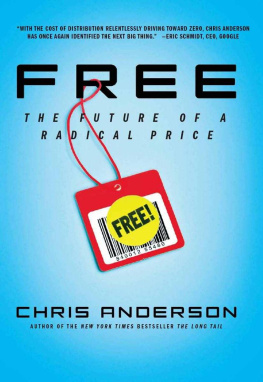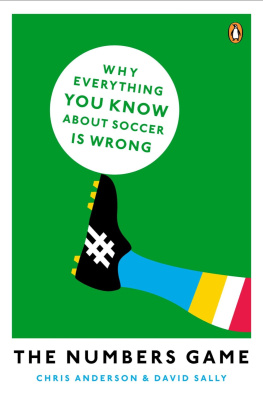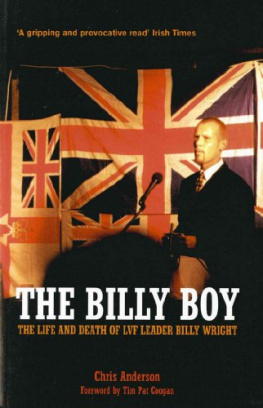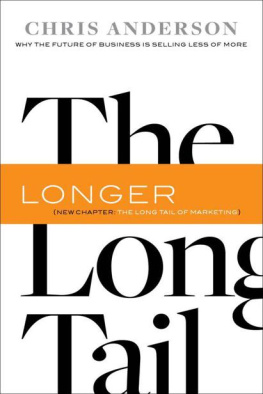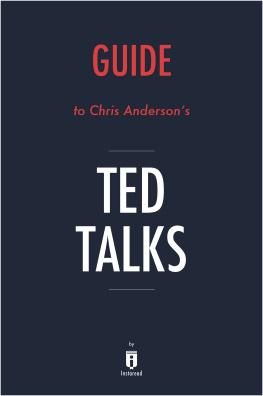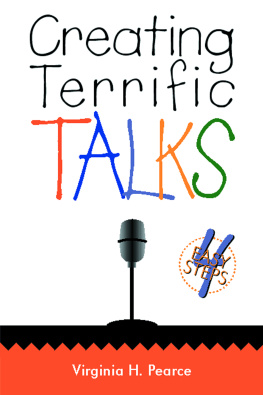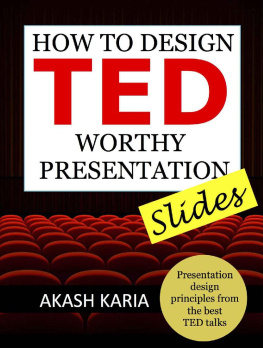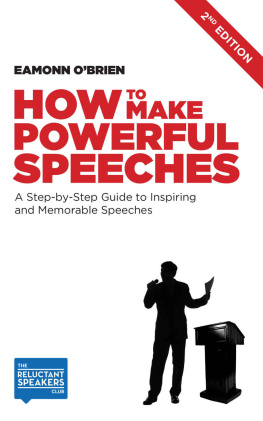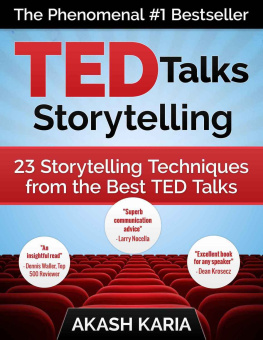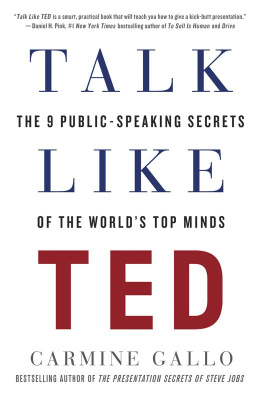Copyright 2016 by Chris Anderson
All rights reserved
For information about permission to reproduce selections from this book, write to or to Permissions, Houghton Mifflin Harcourt Publishing Company, 3 Park Avenue, 19th Floor, New York, New York 10016.
www.hmhco.com
The Library of Congress has cataloged the print edition as follows:
Names: Anderson, Chris, date.
Title: TED talks : the official TED guide to public speaking / Chris Anderson.
Description: Boston : Houghton Mifflin Harcourt, 2016. | Includes index.
Identifiers: LCCN 2015048798 | ISBN 9780544634497 (hardcover) | ISBN 9780544809710 (international edition pbk.)
Subjects: LCSH : Public speakingHandbooks, manuals, etc.
Classification: LCC PN4129 .15 . A54 2016 | DDC 808.5/1dc23
LC record available at http://lccn.loc.gov/2015048798
Cover design by Mike Femia
e ISBN 978-0-544-66436-4
v1.0516
Inspired by Zoe Anderson (19862010).
Life is fleeting. Ideas, inspiration, and love endure.
Prologue
The New Age of Fire
The house lights dim. A woman, her palms sweating, her legs trembling just a little, steps out onto the stage. A spotlight hits her face, and 1,200 pairs of eyes lock onto hers. The audience senses her nervousness. There is palpable tension in the room. She clears her throat and starts to speak.
What happens next is astounding.
The 1,200 brains inside the heads of 1,200 independent individuals start to behave very strangely. They begin to sync up. A magic spell woven by the woman washes over each person. They gasp together. Laugh together. Weep together. And as they do so, something else happens. Rich, neurologically encoded patterns of information inside the womans brain are somehow copied and transferred to the 1,200 brains in the audience. These patterns will remain in those brains for the rest of their lives, potentially impacting their behavior years into the future.
The woman on the stage is weaving wonder, not witchcraft. But her skills are as potent as any sorcery.
Ants shape each others behavior by exchanging chemicals. We do it by standing in front of each other, peering into each others eyes, waving our hands and emitting strange sounds from our mouths. Human-to-human communication is a true wonder of the world. We do it unconsciously every day. And it reaches its most intense form on the public stage.
The purpose of this book is to explain how the miracle of powerful public speaking is achieved, and to equip you to give it your best shot. But one thing needs emphasizing right at the start.
There is no one way to give a great talk. The world of knowledge is far too big and the range of speakers and of audiences and of talk settings is far too varied for that. Any attempt to apply a single set formula is likely to backfire. Audiences see through it in an instant and feel manipulated.
Indeed, even if there were a successful formula at one moment in time, it wouldnt stay successful for long. Thats because a key part of the appeal of a great talk is its freshness. Were humans. We dont like same old, same old. If your talk feels too similar to a talk someone has already heard, it is bound to have less impact. The last thing we want is for everyone to sound the same or for anyone to sound as though hes faking it.
So you should not think of the advice in this book as rules prescribing a single way to speak. Instead think of it as offering you a set of tools designed to encourage variety. Just use the ones that are right for you and for the speaking opportunity youre facing. Your only real job in giving a talk is to have something valuable to say, and to say it authentically in your own unique way.
You may find it more natural than you think. Public speaking is an ancient art, wired deeply into our minds. Archaeological discoveries dating back hundreds of thousands of years have found community meeting sites where our ancestors gathered around fire. In every culture on earth, as language developed, people learned to share their stories, hopes, and dreams.
Imagine a typical scene. It is after nightfall. The campfire is ablaze. The logs crackle and spit under a starry sky. An elder rises, and all eyes turn and lock onto the wise, wrinkled face, illuminated by the flickering light. The story begins. And as the storyteller speaks, each listener imagines the events that are being described. That imagination brings with it the same emotions shared by the characters in the story. This is a profoundly powerful process. It is the literal alignment of multiple minds into a shared consciousness. For a period of time, the campfire participants act as if they were a single life form. They may rise together, dance together, chant together. From this shared backdrop, it is a short step to the desire to act together, to decide to embark together on a journey, a battle, a building, a celebration.
The same is true today. As a leaderor as an advocatepublic speaking is the key to unlocking empathy, stirring excitement, sharing knowledge and insights, and promoting a shared dream.
Indeed, the spoken word has actually gained new powers. Our campfire is now the whole world. Thanks to the Internet, a single talk in a single theater can end up being seen by millions of people. Just as the printing press massively amplified the power of authors, so the web is massively amplifying the impact of speakers. It is allowing anyone anywhere with online access (and within a decade or so, we can expect almost every village on earth to be connected) to summon the worlds greatest teachers to their homes and learn from them directly. Suddenly an ancient art has global reach.
This revolution has sparked a renaissance in public speaking. Many of us have suffered years of long, boring lectures at university; interminable sermons at church; or roll-your-eyes predictable political stump speeches. It doesnt have to be that way.
Done right, a talk can electrify a room and transform an audiences worldview. Done right, a talk is more powerful than anything in written form. Writing gives us the words. Speaking brings with it a whole new toolbox. When we peer into a speakers eyes; listen to the tone of her voice; sense her vulnerability, her intelligence, her passion, we are tapping into unconscious skills that have been fine-tuned over hundreds of thousands of years. Skills that can galvanize, empower, inspire.
What is more, we can enhance these skills in ways the ancients could never have imagined: The ability to showright there in beautiful high-resolutionany image that a human can photograph or imagine. The ability to weave in video and music. The ability to draw on research tools that present the entire body of human knowledge to anyone in reach of a smartphone.
The good news is, these skills are teachable. They absolutely are. And that means that theres a new superpower that anyone, young or old, can benefit from. Its called presentation literacy. We live in an era where the best way to make a dent on the world may no longer be to write a letter to the editor or publish a book. It may be simply to stand up and say something... because both the words and the passion with which they are delivered can now spread across the world at warp speed.
In the twenty-first century, presentation literacy should be taught in every school. Indeed, before the era of books, it was considered an absolutely core part of education, albeit under an old-fashioned name: rhetoric. Today, in the connected era, we should resurrect that noble art and make it educations fourth R: reading, riting, rithmetic... and rhetoric.
The words core meaning is simply the art of speaking effectively. Fundamentally, thats the purpose of this book. To recast rhetoric for the modern era. To offer useful stepping-stones toward a new presentation literacy.
Next page
